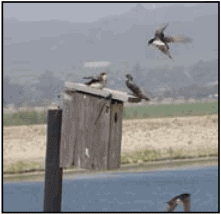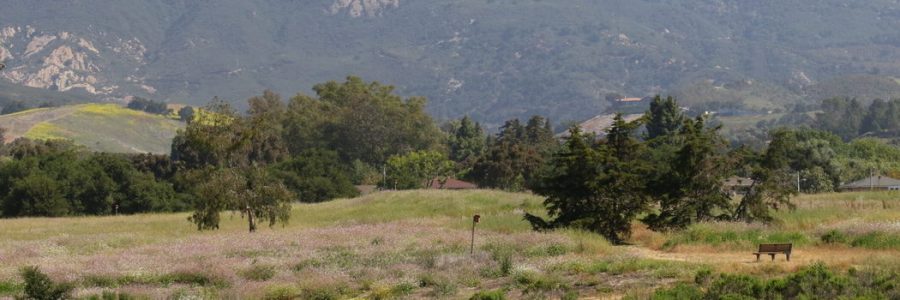Opportunities to Learn Nesting Biology While Improving Our Environment
By Don Schroeder and Dave Eldridge
Introduction
In October, 2004, the Santa Barbara Audubon Society (SBAS) hosted a presentation by Jan Wasserman on the Tree Swallow nest box projects at sites around Ventura. She shared her experience with setting up and conducting these projects. She and a small band of volunteers have been able to establish nesting sites for this species which had previously dropped to the status of being a rare breeder in Ventura and SB Counties.
The tremendously exciting result was that, in a period of about 12 years, over 10,000 young swallows have been fledged from nest boxes around Ventura. It seems very fitting that humans can be such a driving force towards restoring a bird population that had been forced into a steep decline due to human activities such as agriculture and housing development. The Ventura projects are well described on websites (see web addresses at the end of this article). Jan’s talk spurred interest within SBAS of initiating a Tree Swallow nest box project locally. The Tree Swallow naturally nests in tree cavities (often made by woodpeckers). Human development often removes many trees, and those that remain are often groomed in a way that minimizes dead branches most appropriate for cavity nests.
SBAS Nest Box Projects
PAST
Over the past five years, SBAS volunteers have built and set out about 35 nest boxes at two sites, Coal Oil Point Reserve (COPR) and Lake Los Carneros (LLC). Initially, most of the boxes were not used even though Tree Swallows were seen in these areas. Several of the unused boxes were repositioned into more open areas and onto higher ground. Additionally, several boxes were modified by lengthening their support poles (“up”grading) and/or by adding heat shields to prevent their internal temperatures from getting too high during hot summer periods. Some of these moved/modified boxes started getting tenants: Tree Swallows and Western Bluebirds. Other cavity nesters, Bewick’s Wrens and Oak Titmice, were observed to use a few of the boxes. The strategy of moving/modifying boxes that don’t get used for a few years has afforded a steady increase in overall nesting activity and the desired result of nests producing fledglings. Most fledglings have been produced at COPR, but both sites have had success. During 2008, 27 young were fledged from nest boxes. Volunteer Dave Eldridge has been an instrumental force in changing the project from being barely successful into one now showing moderate success. His careful field observations and ideas for positive changes have been significant.
PRESENT
The 2009 nesting season is still in progress. Observations thus far suggest that nest box activity and fledging rates will be similar to 2008. There is still a significant subset of nest boxes that are not used. Further relocations and/or modifications will be considered.
FUTURE
There now exist many opportunities for volunteers to support nest box projects in our area:
- Continue to maintain and monitor existing nest boxes
- Improve current boxes by adding heat shields and/or moving unused boxes to situations that swallows may favor more
- Expand the project by putting boxes in new areas
- Develop an analysis of known/suspected nest box failures in an attempt to increase future success
- Initiate putting leg bands on both nestling and breeding adult Tree Swallows which may afford a better understanding of dispersal of young, survival, and degree of faithfulness to nest sites and to mates.
WHAT IS THE VALUE OF A LOCAL NEST BOX PROJECT?
There is an obvious value in the project to Tree Swallows and Western Bluebirds and to us. These species are not only beautiful but afford beneficial insect control. It is likely that individuals that use nest boxes would probably not have attempted breeding if the boxes had not been available. Therefore, all nest boxes which f ledge young add individuals that might not exist otherwise. Consider the tremendous capacity of production of swallows seen in the Ventura nest box projects. Even if we can’t realize such a large project in the Santa Barbara area, we can still provide a positive impact on our local Tree Swallow and Western Bluebird populations.
But there is another great value to participants in the project. You can learn by experience from one of the best teachers around: the birds themselves. You can observe firsthand nest building, the egg-laying schedule, incubation, the hatching schedule, nestling care, nestling growth, and fledging. You can learn how to check and record nest status, determine the expected hatch date for eggs, judge the age of nestlings and their expected date to leave the nest. You may be able to assist with banding nestlings and adults. Tree Swallows are very tolerant of nest inspections and even of capture and banding. They readily resume normal activities soon after brief human disturbance. There is only a short period, the few days before nestlings are ready to leave the nest, when it is critical that nests not be disturbed. Mortality during nesting is a reality of nature, associated with both natural nests and nest boxes. Some failures are expected, and it is important to document such and try to determine their cause. If we suspect a humanly-controllable cause of failure, we can try to adjust future situations so as to minimize failures. For example, it appeared that certain nest boxes in past years may have suffered mortality by getting too hot during certain weather patterns. One of our volunteers has added heat shields to such boxes, and we will be monitoring their future outcomes.
Of course there will be persons already experienced with the project that can help you get started. If there is enough interest in banding birds and tracking them across years, a federally permitted bander will be available to work with you in banding efforts.
WHO CAN PARTICIPATE? WHAT IS REQUIRED?
There are no particular skills that are required to be a participant in a nest box project. You just need to be able to spend some regular time checking nests. It generally takes only two hours to check 16-17 nest boxes (longer if banding is planned). Nest checks only need to be about once a week during the nesting season, which is approximately April through early July. If you don’t think you can deal with field checks every week, maybe you can be part of a small group so that particular individuals can stagger their times in the field.
Interested children should be encouraged to participate with adults. What a wonderful opportunity to let kids learn about nature and help the environment.
WHAT NEXT?
 If you are interested in learning more about SBAS nest box projects (or other science projects) and may want to participate, please contact either Don Schroeder, Science Advisor, or Niels Johnson-Lameijer, Science Chair. Contact information is on the last page of this newsletter. We will let you know when we can meet in person (possibly at one of the nest box sites) to tell you more about this project and answer questions.
If you are interested in learning more about SBAS nest box projects (or other science projects) and may want to participate, please contact either Don Schroeder, Science Advisor, or Niels Johnson-Lameijer, Science Chair. Contact information is on the last page of this newsletter. We will let you know when we can meet in person (possibly at one of the nest box sites) to tell you more about this project and answer questions.
Even though regular activities of nest box monitoring need not start until next nesting season, late March or April, there are some sporadic activities that should happen while the birds are not breeding. Help is needed to build and repair boxes, evaluate situations where boxes have not been used, move selected boxes as necessary, and plan strategies for improving nesting success during the next breeding cycle.
WEB ADDRESSES FOR FURTHER INFORMATION
Tree Swallows Return to Ventura:
http://www.californiareport.org/archive/R906051630/b (Dead Link ed.)
[Ventura] Tree Swallow Nesting Projects, Inc.:
http://www.treeswallows.org/history.htm (Dead Link ed.)
An extensive resource on Tree Swallow nest box projects:
http://www.treeswallowprojects.com/ (Dead Link ed.)

